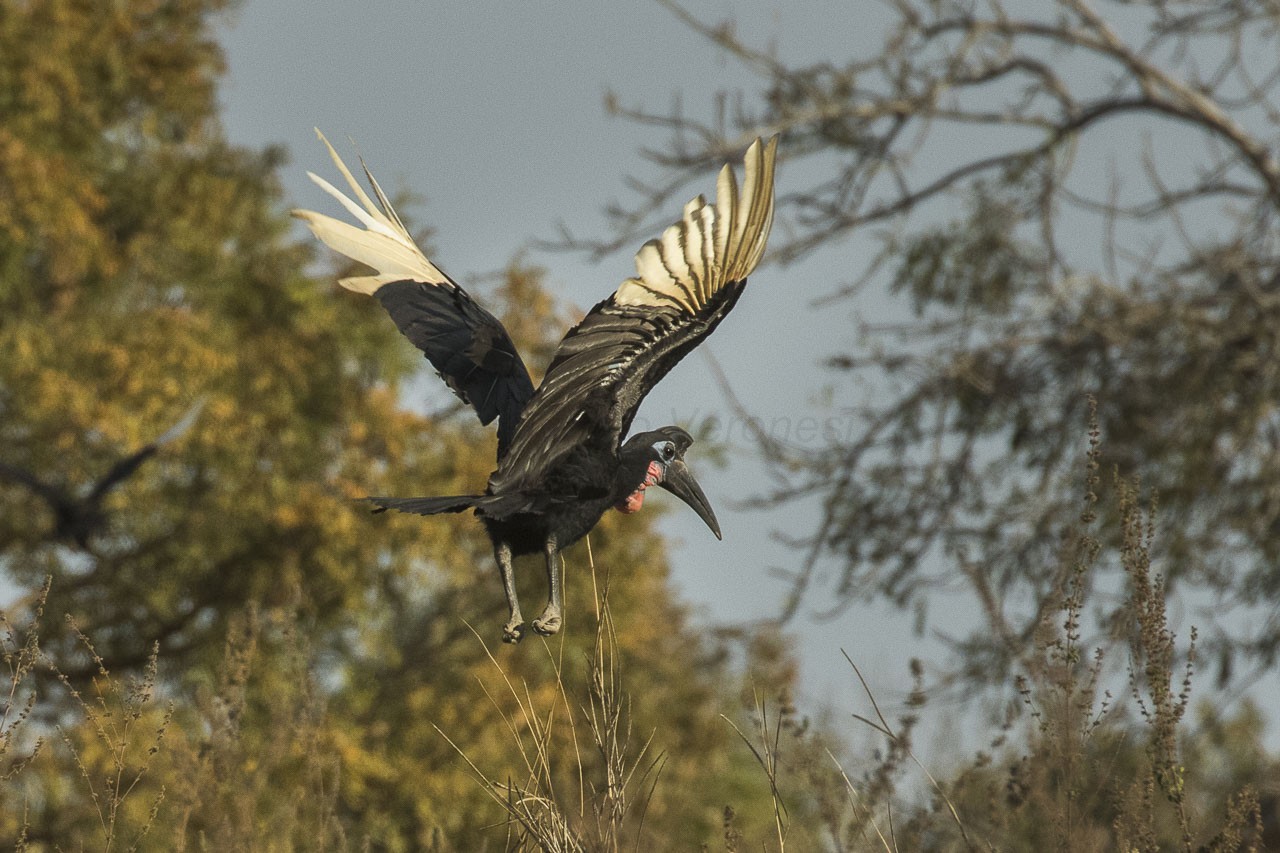Abyssinian Ground Hornbill
A species of Ground Hornbills Scientific name : Bucorvus abyssinicus Genus : Ground Hornbills
Abyssinian Ground Hornbill, A species of Ground Hornbills
Botanical name: Bucorvus abyssinicus
Genus: Ground Hornbills
Content
Description General Info
 Photo By Francesco Veronesi , used under CC-BY-SA-2.0 /Cropped and compressed from original
Photo By Francesco Veronesi , used under CC-BY-SA-2.0 /Cropped and compressed from original Description
Abyssinian ground hornbill is a large, terrestrial hornbill with black body feathers and white primary feathers which are visible in flight. The adult male has a patch of bare blue skin around the eye and an inflatable patch of bare skin on the neck and throat which is red, apart from the upper throat which is blue. The bill is long and black except for a reddish patch at the base of the mandible. On top of the bill there is a short open-ended black casque. The female is similar but smaller with any bare skin being wholly dark blue. Juvenile birds are dark sooty-brown with a smaller bill, with an incipient casque. As the juvenile matures, which usually takes 3 years, it gradually develops the plumage, bare skin colour and casque of the adults. The total length is 90 to 110 cm (35 to 43 in). The Abyssinian ground hornbill has long feathers that look like eyelashes that surround its eyes. These protect the eyes from injury. It reportedly averages around 90 to 100 cm (35 to 39 in) tall, around 110 cm (43 in) and weighs approximately 4 kg (8.8 lb). Per Stevenson and Fanshawe, the Abyssinian is a larger species on average than the southern ground hornbill, at 102 cm (40 in), but published weights and standard measurements contrarily indicate the southern species is indeed slightly larger. 
Size
1 m
Life Expectancy
40 years
Nest Placement
Ground
Feeding Habits
Abyssinian Ground Hornbill forage opportunistically, preying on small animals stirred by ungulates or fires. They walk up to 11 km daily, hunting and digging for prey such as arthropods, rarely eating plants. Their strong bills are specialized for capturing and consuming diverse prey, even attacking bee hives for honeycomb.
Habitat
Abyssinian Ground Hornbill typically dwells in the open savannas and sub-desert scrublands of Northern sub-Saharan Africa. Favoring drier regions with short vegetation, this species thrives in environments that facilitate its ground-foraging behavior. It is also known to inhabit rocky and hilly terrains, with an altitudinal range extending up to 3257 meters in Ethiopia. Essential to abyssinian Ground Hornbill's survival, large trees are utilized as nesting sites within their habitat. While there have been instances of abyssinian Ground Hornbill in Florida, USA, it does not constitute a naturally breeding population.
Dite type
Omnivorous
General Info
Feeding Habits
Bird food type
Behavior
The Abyssinian ground hornbill lives in open grassland, in pairs or small family parties. They patrol their territory by walking and are reluctant fliers, usually only taking to the air when alarmed. In captivity, they can live 35–40 years. Diet in the wild consists of a wide variety of small vertebrates and invertebrates, including tortoises, lizards, snakes, birds, spiders, beetles, and caterpillars; they also take carrion, some fruits, seeds, and groundnuts. Groups of ground hornbills have territories of 2–100 square miles (5.2–259.0 km). They are diurnal. 
Distribution Area
The Abyssinian ground hornbill is found in Northern sub-Saharan Africa from southern Mauritania, Senegal and Guinea east to Eritrea, Ethiopia, north western Somalia, north western Kenya and Uganda. It is found in open habitats such as savanna, sub-desert scrub, and rocky areas, preferring short vegetation which enables its visual foraging technique. The areas inhabited by this species are usually drier areas than the preferred habitat of the Southern ground hornbill. It will tolerate disturbed areas but does require large trees to be used as nest sites. The Abyssinian ground hornbill has escaped or been deliberately released in to Florida, USA, but there is no evidence that the population is breeding and may only persist due to continuing releases or escapes. 
Species Status
The Abyssinian ground hornbill is subject to the loss and degradation of its habitat and it is a quarry of hunters, in a smiliar way to its congener, the Southern ground hornbill, and, as a result, it is thought that the population may have started a rapid decline. As a result of this perceived decline the IUCN give its status as Vulnerable. 
Scientific Classification
Phylum
Chordates Class
Birds Family
Ground hornbills Genus
Ground Hornbills Species
Abyssinian Ground Hornbill